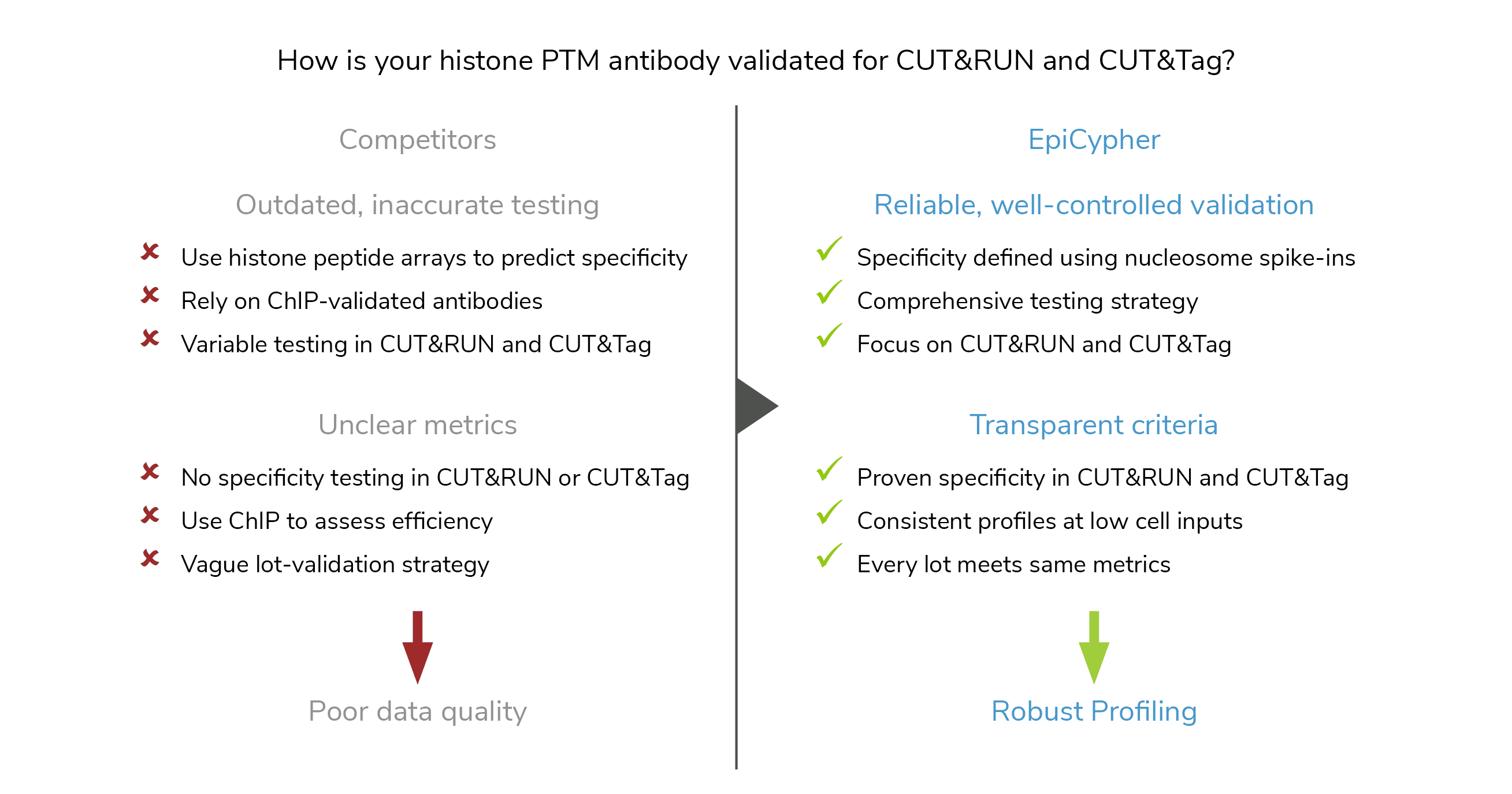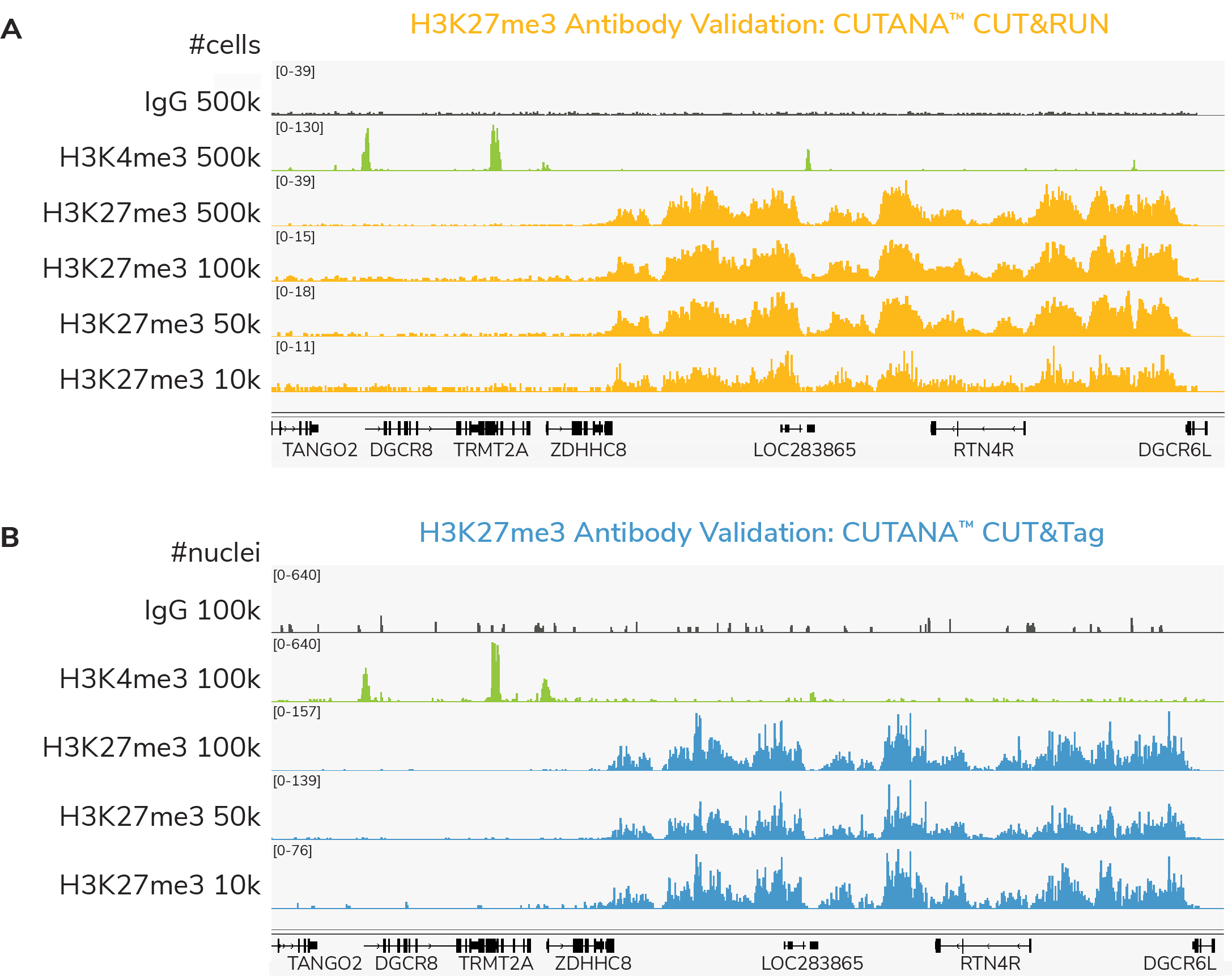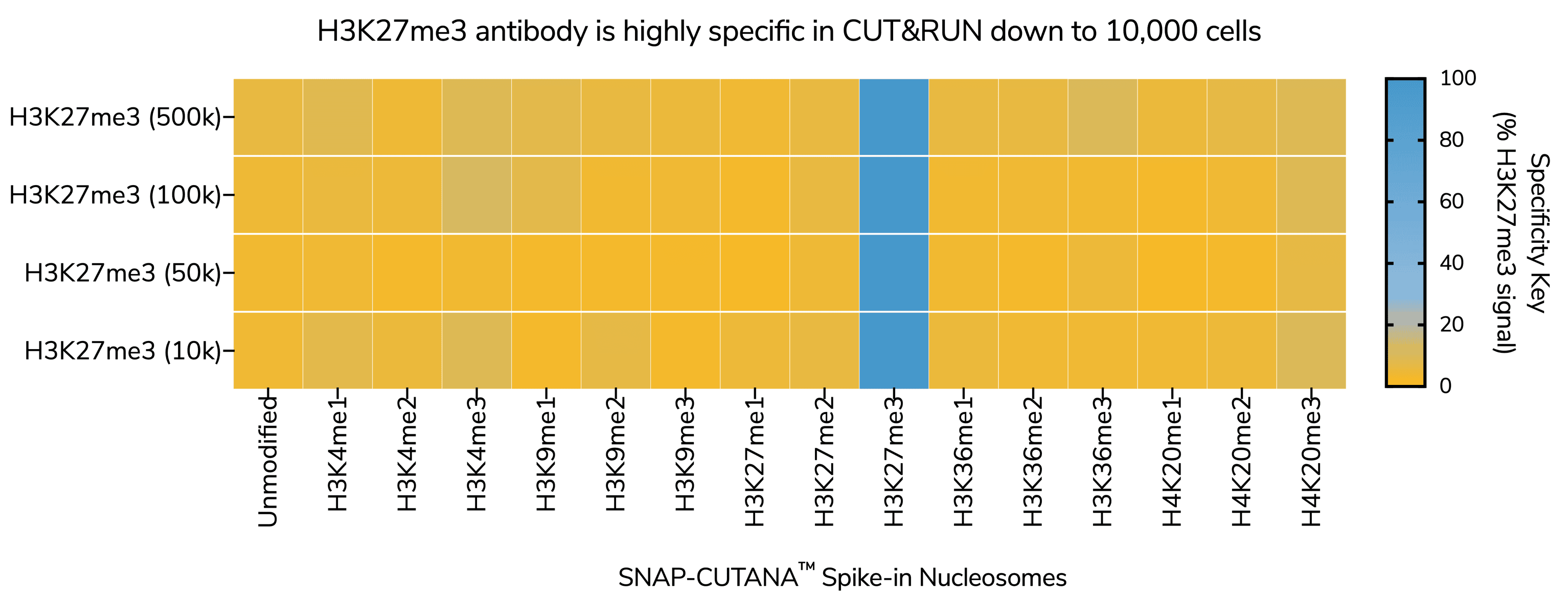How to select the best histone PTM antibody for CUT&RUN and CUT&Tag

EpiCypher’s CUTANA™ CUT&RUN and CUT&Tag technologies are enabling major advancements in high-resolution profiling of histone post-translational modifications (PTMs) across scientific disciplines, including immunology, neuroscience, and cancer research1-3. Antibodies are crucial to the high sensitivity of CUT&RUN and CUT&Tag assays, where they are used to tether enzymes for target-specific cleavage and enrichment.
But not just any antibody will do! In fact, histone PTM antibodies are notoriously unreliable, with high rates of cross-reactivity and poor binding efficiency in chromatin mapping assays. Furthermore, EpiCypher found that histone PTM antibody performance can vary widely between assay types and substrates (i.e. peptides vs. nucleosomes) – making assay-specific testing a must for the epigenetics field4.
To realize the full the potential of CUTANA assays for epigenetics research, EpiCypher developed SNAP-Certified™ antibodies for CUT&RUN and CUT&Tag. Here, we will explore why EpiCypher's antibody validation pipeline results in better antibodies for histone PTM profiling compared to traditional strategies and address common questions to help you select the best antibody for your CUT&RUN and CUT&Tag experiment.
In this post:
- What qualities define a good antibody for CUT&RUN or CUT&Tag?
- Why are most histone PTM antibodies insufficient for CUT&RUN and CUT&Tag?
- What makes EpiCypher’s SNAP-Certified histone PTM antibodies different?
- How are EpiCypher’s SNAP-Certified Antibodies validated?
- Are all SNAP-Certified Antibodies validated for CUT&RUN and CUT&Tag?
- What if EpiCypher doesn’t offer a SNAP-Certified Antibody for my PTM target?
- Can I use my ChIP-validated histone PTM antibody for CUT&RUN or CUT&Tag?
- What about chromatin associated proteins, like transcription factors?
What qualities define a good antibody for CUT&RUN or CUT&Tag?
Employing subpar antibodies in your studies can lead to endless frustration, misleading conclusions, wasted time, and lost resources. High-quality antibodies display three core features:
- Specificity to reliably isolate the target epitope – and nothing else. EpiCypher screened >400 commercial histone PTM antibodies and found that >70% of histone PTM antibodies have unacceptable cross-reactivity in chromatin mapping assays (chromatinantibodies.com), making specificity a major concern in epigenomics research.
- High target efficiency to deliver meaningful biological insights across diverse sample types and inputs. Target efficiency – which is related to antibody binding affinity – is crucial to high-quality chromatin profiling using low cell numbers, primary cells, and/or mapping low abundance epitopes.
- Reproducible sequencing data to ensure confidence in your results. Many antibodies show variable activity across different assays or between production lots, making lot-specific, in-assay antibody testing critical for successful experiments.
High target efficiency and specificity go hand-in-hand during antibody validation. For example, a highly specific antibody will produce poor data in the absence of good efficiency. EpiCypher is the only supplier that has metrics related to antibody binding efficiency AND specificity in CUT&RUN and CUT&Tag (see below).
Shop our validated CUT&RUN antibodies
Why are most histone PTM antibodies insufficient for CUT&RUN and CUT&Tag?
Histone antibodies that failed our antibody screen lacked one or more of the three key features of a good antibody. Namely, failed antibodies (1) were nonspecific, exhibiting high-cross reactivity to related histone PTMs and/or (2) showed low recovery of the target histone PTM (poor efficiency).
Even highly cited antibodies failed our testing4. This high failure rate could be the result of several factors:
- Using modified histone peptides to define specificity. Historically, histone peptide arrays were used to confirm PTM specificity for chromatin mapping. However, peptide substrates do NOT reliably predict PTM antibody performance for ChIP, CUT&RUN, or CUT&Tag, since they lack the structural context of cellular chromatin and behave differently than nucleosomes in binding assays4.
- Selecting for nonspecific antibodies with high yield/efficiency. The use of nonphysiological substrates to define antibody specificity complicates efficiency testing (see previous question). Indeed, selection of a nonspecific antibody that exhibits high DNA yield would still fail to generate biologically meaningful data because it would not capture the correct target.
- Validation in unrelated assays. Antibody performance varies widely across assays. A PTM antibody that works well in a western blot or ELISA may not work at all for CUT&RUN or CUT&Tag. Distinctions also exist between chromatin mapping assays; for instance, EpiCypher has found that many ChIP-validated antibodies do NOT work well for CUT&RUN/CUT&Tag (see this question for info).
Together, these factors highlight the importance of validating histone PTM antibodies in the desired end application using defined panels of nucleosomes – the physiological target in chromatin mapping assays. EpiCypher’s CUT&RUN and CUT&Tag histone PTM antibody validation strategy utilizing SNAP-CUTANA™ nucleosome spike-in controls uniquely addresses these concerns, providing high-quality reagents for robust CUT&RUN and CUT&Tag profiles (Figure 1).

What makes EpiCypher’s SNAP-Certified histone PTM antibodies different?
EpiCypher is the only company that supports both CUT&RUN and CUT&Tag assays. As such, we have developed a distinct approach to validate histone PTM antibodies that ensures reliable CUT&RUN and/or CUT&Tag profiling (Figure 1).
- Direct testing against physiological nucleosome substrates in the target application. We combine our extensive experience in CUT&RUN and CUT&Tag assay development with our exclusive SNAP Spike-in technology, which uses panels of defined nucleosomes carrying on- and off-target PTMs to directly quantify antibody performance in chromatin mapping assays.
- Emphasis on antibody specificity and efficiency. Our SNAP Spike-in testing strategy is the only method that uses physiological nucleosome substrates to define PTM antibody specificity in CUT&RUN and CUT&Tag. We pair specificity analysis with testing across a 10-fold dilution of cell inputs to confirm consistent genomic enrichment, making it the most accurate approach for CUT&RUN and CUT&Tag antibody validation.
Only antibodies that pass ALL key performance metrics earn the SNAP-Certified designation (see the next question, below).
How are EpiCypher’s SNAP-Certified Antibodies validated?
Our antibody development and validation efforts begin with screening hundreds of candidate clones against nucleosomes with on- and off-target histone PTMs. Antibodies with high specificity for the intended target are tested in CUT&RUN and CUT&Tag assays with SNAP Spike-in Controls to identify the best reagents for our customers. Antibodies are evaluated on the core features described above, and must meet the following metrics to pass testing:
- Specificity: SNAP-Certified Antibodies must exhibit less than 20% cross-reactivity to related histone PTMs in the SNAP Spike-in Panel. Most of our antibodies surpass this metric, with <10% off-target binding.
- Efficiency: SNAP-Certified Antibodies must exhibit consistent genomic enrichment (i.e. peak structures) across cell inputs. For CUT&RUN this is 500k and 50k K562 cells and for CUT&Tag this is 100k and 10k K562 cells. See Figure 2 for validation data for our H3K27me3 antibody (coming soon).
- Reproducibility: Each lot is individually tested to ensure performance consistency.

Are all SNAP-Certified Antibodies validated for both CUT&RUN and CUT&Tag?
Not always. Below is a list of SNAP-Certified Antibodies for CUT&RUN vs. CUT&Tag. As CUT&RUN is a more robust assay and has higher cell input requirements, more antibodies tend to meet the required metrics.
- CUT&RUN: H3K4me1 (coming soon), H3K4me2, H3K4me3, H3K9me1, H3K27me1, H3K27me3 (coming soon), H3K36me3 (coming soon), H4K20me3
- CUT&Tag (coming soon): H3K4me1, H3K27me3
Note that EpiCypher also offers a collection of CUT&RUN validated antibodies to chromatin-associated proteins, including transcription factors, chromatin readers, writers, and remodeling enzymes.
What if EpiCypher doesn’t offer a SNAP-Certified Antibody for my PTM target?
Our goal is to deliver best-in-class antibodies to enable your chromatin research, and we are regularly screening and identifying new SNAP-Certified Antibodies for CUT&RUN and CUT&Tag. We do NOT recommend relying on ChIP-validated antibodies for CUTANA assays (see below), as antibody performance can vary widely across platforms. If we don’t offer a validated antibody for your target, we suggest the following steps to identify the optimal antibody for your target.
- Obtain 3-5 antibodies (preferably monoclonal) to your PTM from various vendors. Make sure that the antibodies target distinct epitopes. Should you need recommendations, contact us.
- EpiCypher scientists have observed that antibodies good for immunofluorescence (IF) applications tend to produce good data in our CUTANA CUT&RUN assays. Although using IF-validated antibodies is NOT a guarantee for success, it may help guide CUT&RUN antibody selection for targets that lack validated reagents.
- Perform CUT&RUN or CUT&Tag (depending on intended assay) with all candidate antibodies.
- Use native (unfixed) cells or nuclei and follow cell number recommendations from the EpiCypher CUTANA protocols. For CUT&RUN, use 500k cells per reaction; for CUT&Tag, use 100k nuclei per reaction.
- Include reactions with positive and negative control antibodies (e.g. EpiCypher H3K4me3 or H3K27me3 SNAP-Certified Antibody and EpiCypher Rabbit IgG Antibody, respectively). Add the SNAP-CUTANA K-MetStat Panel to control reactions to gauge experimental success (see the SNAP-CUTANA Spike-in User Guide).
- For antibodies to lysine methylation PTMs, add the SNAP-CUTANA K-MetStat Panel to reactions for quantitative antibody validation.
- NOTE: for labile histone PTM, such as histone lysine acetylation, lightly cross-linking cell samples may stabilize marks and improve assay performance.
- Confirm that libraries from positive and negative controls show expected sequencing data. SNAP-CUTANA Spike-ins should show low, nonspecific recovery in the negative control reaction, while the positive control reaction should only recover spike-ins carrying the target PTM (e.g. H3K27me3 with less than 20% cross-reactivity to off-targets; see Figure 3 for an example). Positive controls should also generate robust peaks in expected genomic regions (i.e. promoters for H3K4me3; see Figure 2).
- Examine sequencing data and compare the profiles from target antibodies as follows:
- Lysine methylation PTMs: Antibodies should show <20% cross-reactivity using the SNAP-CUTANA K-MetStat Panel. Confirm the expected genomic enrichment consistent with the known PTM target biology (e.g., broad vs. narrow peaks at characteristic functional elements) and high signal-to-noise.
- For other PTMs: Compare results and select a specific antibody based on yields, expected target enrichment, and signal-to-noise in sequencing data. Additional SNAP Spike-in panels for lysine acetylation and ubiquitylation targets are coming soon.
Additional controls and recommendations:

Using high-quality, specific antibodies will make a huge difference in the biological accuracy and value of your results. EpiCypher is committed to defining the best histone PTM antibodies for your genomic mapping studies, so you can be confident in your data. Keep up to date with our latest antibody news by subscribing below.
Can I use my ChIP-validated histone PTM antibody for CUT&RUN or CUT&Tag?
You may attempt – but fair warning: EpiCypher has found that using a good ChIP antibody does NOT guarantee success in CUT&RUN and CUT&Tag. This is largely due to differences in sample prep and processing steps, since ChIP prefers heavily cross-linked cells, stringent wash buffers, and bead-coupled antibodies, all of which help maximize the signal-to-noise ratio. In contrast, CUT&RUN/CUT&Tag use native chromatin, mild washes, and antibodies in solution, reflecting the increased sensitivity of these newer strategies.
The only way to know if your antibody will work in CUT&RUN and/or CUT&Tag is if the antibody has been tested in these assays. Antibody validation using ChIP, immunoblot, ELISA, IHC, or other techniques is not a predictor of CUT&RUN or CUT&Tag performance.
What about chromatin-associated proteins, like transcription factors?
We offer CUT&RUN antibodies to diverse chromatin-associated proteins, including transcription factors (e.g. CTCF), chromatin reader proteins (e.g. BRD4), chromatin modifying enzymes (e.g. MLL1), remodelers (e.g. SMARCA2 & SMARCA4), and even commonly used epitope tags (e.g. HA).
Each of our protein antibodies is validated for high signal-to-noise in CUT&RUN and generate genomic distribution profiles consistent with the reported function of the target protein (for example, DNA binding motif analysis for transcription factors). Every lot of antibody is validated directly in CUT&RUN mapping assays to ensure reliable results. However, because SNAP Spike-ins are nucleosomes and do not carry the protein epitope, we cannot offer SNAP-Certified Antibodies for chromatin-associated proteins.
Note that we do NOT recommend using CUT&Tag for profiling transcription factors and other chromatin-associated proteins. CUT&RUN is a more user-friendly and robust technique for mapping proteins. See this blog for more information.
If we don’t offer a CUT&RUN validated antibody to your protein target, we recommend testing 3-5 antibodies and selecting the antibody that best balances the need for robust DNA yields, enrichment for expected sequence motifs and/or peak structures, and high signal over background. Testing native and lightly cross-linked cell samples is also ideal for protein targets.
Shop CUTANA CUT&RUN antibodies here
Don’t let bad antibodies spoil your results – let EpiCypher help! Sign up below or reach out to our technical support team.
References
- Amatullah H et al. Epigenetic reader SP140 loss of function drives Crohn's disease due to uncontrolled macrophage topoisomerases. Cell 185, 3232-47.e18 (2022). PubMed PMID: 35952671.
- Zhu X et al. Acute depletion of human core nucleoporin reveals direct roles in transcription control but dispensability for 3D genome organization. Cell Rep 41, 111576 (2022). PubMed PMID: 36323253.
- Sanchez-Priego C et al. Mapping cis-regulatory elements in human neurons links psychiatric disease heritability and activity-regulated transcriptional programs. Cell Rep 39, 110877 (2022). PubMed PMID: 35649373.
- Shah RN et al. Examining the Roles of H3K4 Methylation States with Systematically Characterized Antibodies. Mol Cell 72, 162-77.e7 (2018). PubMed PMID: 30244833.
